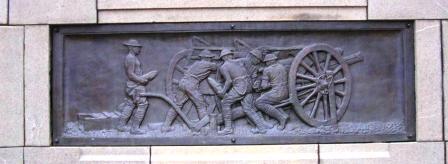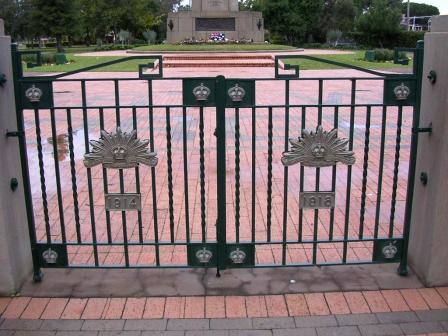Dubbo War Memorial, NSW.
The City of Dubbo is located in western NSW (32o14’46.70”S, 145o36’15.16”E ) and is the location of the FFFAIF’s second Regional Meeting for 2009. The population of Dubbo is nearing 40,000 people with a regional population in excess of 120,000 people.
Photo: Dubbo War Memorial [Graeme Hosken]
A crowd of nearly 4,000 people gathered for the unveiling of the Dubbo War Memorial in Victoria Park on 25 April 1925. The memorial was unveiled by Brigadier General James Heane, DSO, CMG, CB who was educated at Dubbo Superior School and served as the Area Officer for Militia Training prior to the Great War.
Photo: Brigadier General James Heane [AWM Collection]
The War Memorial was designed by Sydney architects H.Crone and R.W. Hinton and features three bronze panels by leading sculptor Raynor Hoff. These panels were the only commission that Hoff undertook for a town committee. No names are listed on the memorial.
Photo: Bronze panels by Sculptor Raynor Hoff. [Graeme Hosken]
The National Archives of Australia project Mapping Our Anzacs shows that 2055 men enlisted at Dubbo for service in the Great War.
Photo: Patriotic Parade 1916 – Dubbo. [State Library NSW]
In 1995 a stone obelisk was built to display the names of those who made the supreme sacrifice in both World Wars.
The names of 105 soldiers from the Great War appear on the obelisk. One of the names appearing on the honour roll is SILLAR R.A. Captain Roy Allen Sillar was a doctor who enlisted with the Australian Army Medical Corps (AAMC) who died as the result of an accident, while based on the Salisbury Plain, on 30 June 1918.
Photo: Grave of Captain Roy Sillar. [Chris Munro]
Captain Roy Sillar is buried at Compton Chamberlayne (via Dinton), Wiltshire, England (51° 3’56.70″N, 1°57’36.52″W). To read Captain Sillar’s story click here.
The Memorial Drive linking the two memorials is dedicated to the memory of those men and women who lost their lives in the defence of their country in 1914 -1918 and 1939 – 1945.
Photo: Memorial Gates [Graeme Hosken]
FFFAIF will be holding its second regional meeting for the year in Dubbo. For details on the meeting click here.
*****
The Families and Friends of the First AIF thanks the Australian, UK and French governments for affording Australian and British soldiers – presently buried in mass graves at Pheasant Wood – dignified individual reburials in a new CWGC cemetery at Fromelles, and applauds Minister Snowdon and his British counterpart, Parliamentary Under-Secretary of State for Defence and Minister for Veterans, Kevan Jones MP, for their joint decision to DNA test the remains at exhumation and use every reasonable method to attempt identification of each soldier.









